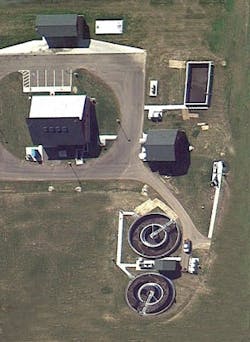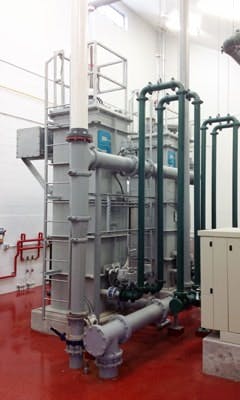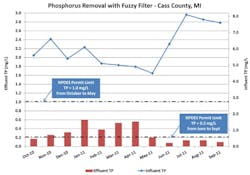Michigan Facility Achieves Phosphorus Removal Goals
The Cass County, Mich., Lakes Area Sewer Authority (LASA) wastewater treatment plant is meeting its phosphorus removal needs by utilizing Schreiber’s Continuously Sequencing Reactor (CSR) biological process technology combined with the company’s compressible media filter, the Fuzzy Filter, for tertiary filtration.
LASA is an activated sludge facility utilizing biological nutrient removal (BNR), clarification, tertiary filtration, ultraviolet disinfection and post-aeration technologies to provide a high-quality effluent. The initial design was for 0.25 mgd average daily flow and includes provisions that allow the plant to be expanded to 1 mgd. LASA experiences extremely varying flows, from 3,500 gpd in the winter to over 175,000 gpd during the summer. Also, the plant receives up to 10,000 gpd of septage. The plant is designed to discharge into a trout stream and must maintain a continuous total phosphorus effluent of less than 0.2 mg/L in the summer.
Heating Up in the Summer
The biological process consists of a Schreiber CSR system—a BNR system contained in a single basin. The CSR continuously sequences through the oxic, anoxic and anaerobic cycles. After the anaerobic cycle is complete and the next oxic phase begins, the system takes advantage of “luxury uptake” of phosphorus to reduce the amount of soluble phosphorus. Side benefits of the Schreiber CSR system include energy savings of 30% or more from 100% aeration turndown capability, low-energy mixing—2.5–3.5 hp/mg—and adjustable controls and programming with the use of Schreiber’s SchreiberFlex control system.
In order to insure that LASA’s summer phosphorus limit is achieved, Schreiber’s Fuzzy Filters provide tertiary filtration. A high-rate (40+ gpm/sq ft) solids-capture filtration system, the Fuzzy Filter provides solids capture, and thereby any phosphorus contained therein, down to 4-micron particle size. Additionally, the Fuzzy Filter provides long media life (10+ years), low-wash water usage (< 2% on tertiary) and, due to the high rate of filtration, a small footprint (15-20% of the size of sand filters).
“I love the Fuzzy Filter,” said LASA Operator Jack Niemi. “Low maintenance, easy operation, and awesome performance. We have a very strict phosphorus effluent limit, and the Fuzzy Filter has ensured that we stay in compliance.”
Additional Schreiber equipment at the plant includes an aerobic digester/thickener in which the thickener can easily be converted into a clarifier (thus satisfying the state’s requirement for clarifier duality), as well as stationary diffuser assemblies, blowers and control equipment installed in a sludge storage basin.
Success story
The plant—designed by Wightman & Associates, Inc. and opened in 2010—has won several awards during its short existence: the 2011 Graham Woodhouse Intergovernmental Efforts Award and two awards from the American Society of Civil Engineers—the Quality of Life Award (Southwest Michigan Chapter, April 2011) and the State Award (June 2011).
Data from the plant indicates that the CSR system removes over 98% of the influent biochemical oxygen demand and ammonia. The cyclic aeration operation of the CSR has allowed approximately 90% of the influent phosphorus to be removed “biologically” and without the use of chemicals. The Fuzzy Filters provide the final crucial step in phosphorus removal. Summer total phosphorus effluent levels at the plant have averaged approximately 0.1 mg/L.
[Visit Schreiber's W&WD Storefront]
“Combining Schreiber’s Continuously Sequencing Reactor with the Fuzzy Filter helped the Lakes Area Sewer Authority meet a low phosphorus effluent limit (0.2 mg/L) and lowered operational cost due to reduced aeration usage and chemical dosing,” said Alan Smaka, an engineer with Wightman & Associates.


